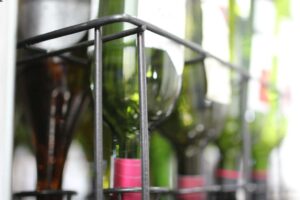In the wine industry, the standard wine bottle is used as a unit of volume across the world to describe sales. Also referred to as a Bordeaux bottle size, this type of wine bottle contains 750ml. This volume became the standard worldwide after it was incorporated into Title 27 of the Code of Federal Regulations of the United States’ government.
In the United-States, the s
In the present-days, it is the most common type of wine bottle and is used for a wide variety of wines all around the globe. Chardonnay, Sangiovese, Cabernet Sauvignon, all may find their place inside this elegant receptacle.
But, alas, wine bottles aren’t all about sophistication and celebration, they also have their downsides. Indeed, even though most bottles today are made of 15 to 50% of cullet (recycled or waste glass), the production of bottles remains the emitter of 60% of the wine industry’s carbon emissions. The calculated CO2 emissions of a standard wine bottle throughout its lifetime are between 0.9 to 2.0kg. That might seem like a negligible number, however, paired with the knowledge that every year 36 billion wine bottles are produced on the planet, they become rather intimidating.
For this reason, our company offers machines that will help recycle and reuse your bottles. Aquatech-BM’s energy-efficient bottle-washers and rinsing machine introduces a green and efficient way of cleaning your receptacles. This technology doesn’t need much water to properly sanitize your bottles; it’s high temperatures do all the work!
Wine producers, keep your precious time for some relaxing activities and trust Aquatech-BM’s bottle-washers to deal with those dirty bottles!
Take a look at our wine bottle cleaner
Wine bottles have a rich history that dates back thousands of years, evolving alongside the wine-making process itself. The use of glass bottles for storing wine became prevalent in the 17th century, marking a significant shift from earlier containers such as amphorae and wooden barrels. This transition was largely due to the development of cork stoppers and improvements in glass-making technology, which together allowed for better preservation of wine’s quality and flavor over time.
The shape, size, and color of wine bottles have varied historically, influenced by regional practices and the types of wine they were designed to hold. For example, the Bordeaux bottle, with its straight sides and high shoulders, is distinct from the Burgundy bottle, which has sloping shoulders. The dark green color of many wine bottles is not merely aesthetic; it helps protect the wine from light, which can degrade its quality.
The introduction of the standard 750ml bottle size is a relatively recent development in the history of wine, becoming widespread only in the 19th century as a convenient size for consumers and for transport. Before this standardization, wine was sold in a variety of bottle sizes and shapes, often specific to the region of production.
Historically, bottles were hand-blown, making each one unique. However, with the advent of industrial glass-making techniques in the 19th century, bottles became more uniform in shape and size, facilitating mass production and distribution. This industrialization process coincided with the global spread of wine culture, making wine accessible to a broader audience and integrating bottles into the cultural iconography of wine.
Today, wine bottles not only serve a practical purpose in storing and aging wine but also carry cultural and historical significance, embodying centuries of tradition in winemaking and consumption.
For an in-depth exploration of the history of wine bottles, “Wine: The 8,000-Year-Old Story of the Wine Trade” by Thomas Pellechia provides a comprehensive overview, tracing the evolution of wine storage and packaging from ancient times to the modern day. This source delves into how technological, cultural, and economic factors have shaped the development of wine bottles, offering readers detailed insights into their historical significance.
Source, “Wine: The 8,000-Year-Old Story of the Wine Trade” by Thomas Pellechia